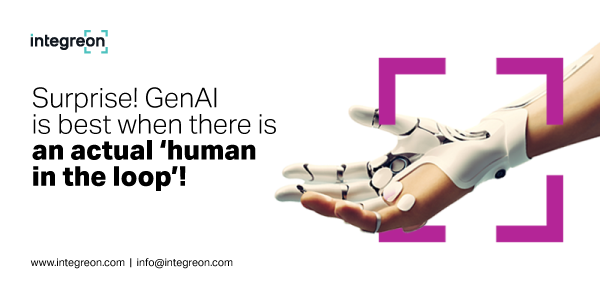Almost daily, the power of generative artificial intelligence (genAI) reveals itself through new use cases, applications, and platforms. No one can argue that this technology is here to stay and the impact on speed and efficiency is unprecedented. And like genAI, the more we use it, the more we learn.
Perhaps the most significant learning is that genAI cannot or more specifically should not be permitted to stand on its own, especially when supporting the legal arena. Optimal output is not simply a question or keystroke away. Enter the human into the loop.
Anyone can tell you a process is only as good as its quality control, typically overseen by subject matter experts there to ensure guidelines are met, consistent quality is maintained, and continuous improvement is achieved. For genAI specifically, human supervision addresses:
Quality: GenAI can be fallible producing errors, hallucinations, and even inappropriate responses. The human in the loop is there to ensure output meets established standards of accuracy, completeness, and integrity.
Ethics: This is an area that clearly requires human review to flag content that may be perceived as biased, discriminatory, or offensive in nature. The system will not have a sufficiently nuanced sensitivity and understanding for what is and is not acceptable.
Interpretation: While genAI is impressive in some settings, understanding the context of a word, situation, email, even an emoji can be critical and not always assured when using genAI. A human with knowledge of the variables of a situation or environment is invaluable in reviewing genAI generated content prior to use.
Refinement: Having a human-in-the-loop QC not only addresses the quality of the machine output but allows for adjustments, adaptation, and more particular alignment with company objectives and requirements. Iterative human feedback can also help the system to learn, perform better and improve over time.
Compliance: When leveraged, genAI can dramatically speed up tasks and gain efficiency. It is important to bear in mind, however, that in any circumstance where absolute accuracy, completeness, or sensitivity is required, human oversight and judgement is a must have part of the process.
Creativity: Certain tasks require human creativity, judgment, and intuition that AI may not currently possess. Human intervention is necessary for tasks where subjective judgment plays a crucial role.
Querying: GenAI only answers what is asked. Therefore, it is humans that need to develop and pose the questions. Humans choose what and how to make inquiries, along with which AI models to use to create the response and which data sources to leverage to limit the frame of reference and optimize accuracy and efficiency of use.
Unknown: The AI system is trained on a finite (albeit very large) data set and can only respond with what it knows and has learned. Mere mortals, on the other hand, are far better equipped to address unpredictable and unforeseen scenarios.
If organizations have learned anything as it relates to introducing new technology into their business and processes, it is that it requires an investment in oversight, input, and control conducted by humans with relevant expertise. The absence of a balance between automation and human processes and intervention can produce disappointing quality and even high-risk exposure.
Many organizations are ensuring that balance by leveraging the technical, process, and subject matter expertise of outsourced providers who are skilling up to support genAI environments and tools to deliver their services. In doing so, in-house teams can focus on more strategic higher complexity work, assured that they are reaping the benefits of genAI while mitigating their risk and maintaining their quality standards.
Go ahead and embrace genAI technology, but always keep a human in the loop!


